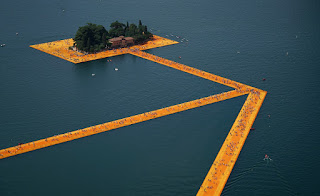R.I.P Christo
Most artists are familiar with the zeitgeist of a beginning seed idea. It can be an image or a word that you've seen that grows in interesting shapes over time. I always see pieces of music as being in a state of growth. All are essentially prototypes of what they could eventually become as resolved works. But even when they're done you're not done. All works are generative in nature. Jazz is the most organic form because it involves real-time improvisation on basic ideas (the "changes").
David Lynch always speaks about the power in ideas and intuitions about them, which he allows to grow organically.
Christo's early series was titled "Inventory", which involved the wrapping of various objects as a kind of mache and coated with paint--a form of arte povera. The power is in the serialized idea or process and can set the stage for a lifetime of art-making based on simple themes.
Richard Serra has followed a similar path, many pieces arising from his Verblist (1968). (It's interesting that it includes “to surround” and “to wrap”). This list is the corollary of the lead sheet in jazz: you are provided with just the instructions.
Christo was essentially a land artist like Michael Heizer or Robert Smithson or James Turrell. The era of land art, so rooted in the environmental movement, may become ancient history. The nature of these large visionary projects is that they have enough institutionalized knowledge that they could be continued by other people or foundations. But once the artist dies, the essence of the idea is gone because aside from records they have kept.
The legacy he leaves is the power of simple themes, supremely executed, like the elegance of a bridge or skyscraper that is as strong as it appears to be fragile. That's a good instruction to make something, even as a jazz composition.



Comments